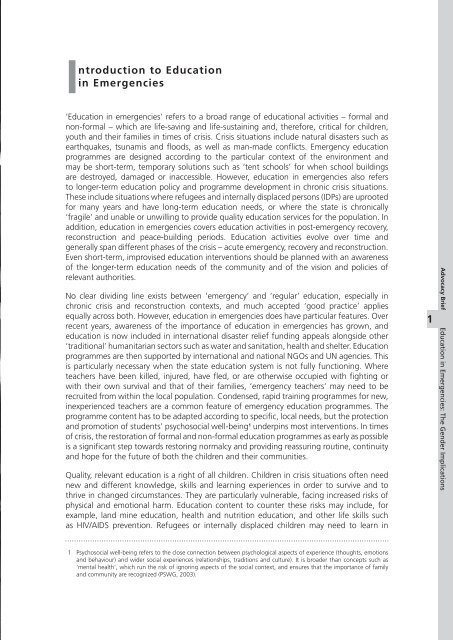Education in Emergencies: The Gender Implications - INEE
Education in Emergencies: The Gender Implications - INEE
Education in Emergencies: The Gender Implications - INEE
- No tags were found...
You also want an ePaper? Increase the reach of your titles
YUMPU automatically turns print PDFs into web optimized ePapers that Google loves.
Introduction to <strong>Education</strong><strong>in</strong> <strong>Emergencies</strong>‘<strong>Education</strong> <strong>in</strong> emergencies’ refers to a broad range of educational activities – formal andnon-formal – which are life-sav<strong>in</strong>g and life-susta<strong>in</strong><strong>in</strong>g and, therefore, critical for children,youth and their families <strong>in</strong> times of crisis. Crisis situations <strong>in</strong>clude natural disasters such asearthquakes, tsunamis and floods, as well as man-made conflicts. Emergency educationprogrammes are designed accord<strong>in</strong>g to the particular context of the environment andmay be short-term, temporary solutions such as ‘tent schools’ for when school build<strong>in</strong>gsare destroyed, damaged or <strong>in</strong>accessible. However, education <strong>in</strong> emergencies also refersto longer-term education policy and programme development <strong>in</strong> chronic crisis situations.<strong>The</strong>se <strong>in</strong>clude situations where refugees and <strong>in</strong>ternally displaced persons (IDPs) are uprootedfor many years and have long-term education needs, or where the state is chronically‘fragile’ and unable or unwill<strong>in</strong>g to provide quality education services for the population. Inaddition, education <strong>in</strong> emergencies covers education activities <strong>in</strong> post-emergency recovery,reconstruction and peace-build<strong>in</strong>g periods. <strong>Education</strong> activities evolve over time andgenerally span different phases of the crisis – acute emergency, recovery and reconstruction.Even short-term, improvised education <strong>in</strong>terventions should be planned with an awarenessof the longer-term education needs of the community and of the vision and policies ofrelevant authorities.No clear divid<strong>in</strong>g l<strong>in</strong>e exists between ‘emergency’ and ‘regular’ education, especially <strong>in</strong>chronic crisis and reconstruction contexts, and much accepted ‘good practice’ appliesequally across both. However, education <strong>in</strong> emergencies does have particular features. Overrecent years, awareness of the importance of education <strong>in</strong> emergencies has grown, andeducation is now <strong>in</strong>cluded <strong>in</strong> <strong>in</strong>ternational disaster relief fund<strong>in</strong>g appeals alongside other‘traditional’ humanitarian sectors such as water and sanitation, health and shelter. <strong>Education</strong>programmes are then supported by <strong>in</strong>ternational and national NGOs and UN agencies. Thisis particularly necessary when the state education system is not fully function<strong>in</strong>g. Whereteachers have been killed, <strong>in</strong>jured, have fled, or are otherwise occupied with fight<strong>in</strong>g orwith their own survival and that of their families, ‘emergency teachers’ may need to berecruited from with<strong>in</strong> the local population. Condensed, rapid tra<strong>in</strong><strong>in</strong>g programmes for new,<strong>in</strong>experienced teachers are a common feature of emergency education programmes. <strong>The</strong>programme content has to be adapted accord<strong>in</strong>g to specific, local needs, but the protectionand promotion of students’ psychosocial well-be<strong>in</strong>g underp<strong>in</strong>s most <strong>in</strong>terventions. In timesof crisis, the restoration of formal and non-formal education programmes as early as possibleis a significant step towards restor<strong>in</strong>g normalcy and provid<strong>in</strong>g reassur<strong>in</strong>g rout<strong>in</strong>e, cont<strong>in</strong>uityand hope for the future of both the children and their communities.Quality, relevant education is a right of all children. Children <strong>in</strong> crisis situations often neednew and different knowledge, skills and learn<strong>in</strong>g experiences <strong>in</strong> order to survive and tothrive <strong>in</strong> changed circumstances. <strong>The</strong>y are particularly vulnerable, fac<strong>in</strong>g <strong>in</strong>creased risks ofphysical and emotional harm. <strong>Education</strong> content to counter these risks may <strong>in</strong>clude, forexample, land m<strong>in</strong>e education, health and nutrition education, and other life skills suchas HIV/AIDS prevention. Refugees or <strong>in</strong>ternally displaced children may need to learn <strong>in</strong>Advocacy Brief <strong>Education</strong> <strong>in</strong> <strong>Emergencies</strong>: <strong>The</strong> <strong>Gender</strong> <strong>Implications</strong>Psychosocial well-be<strong>in</strong>g refers to the close connection between psychological aspects of experience (thoughts, emotionsand behaviour) and wider social experiences (relationships, traditions and culture). It is broader than concepts such as‘mental health’, which run the risk of ignor<strong>in</strong>g aspects of the social context, and ensures that the importance of familyand community are recognized (PSWG, 2003).
















